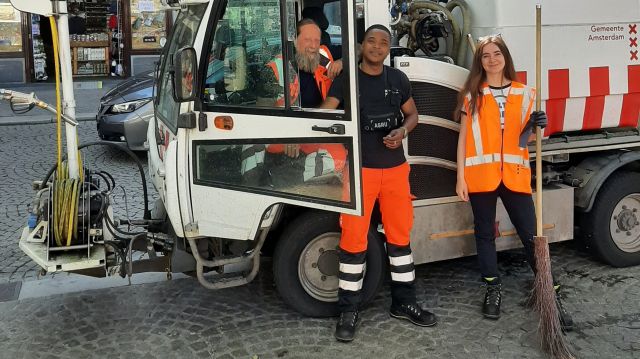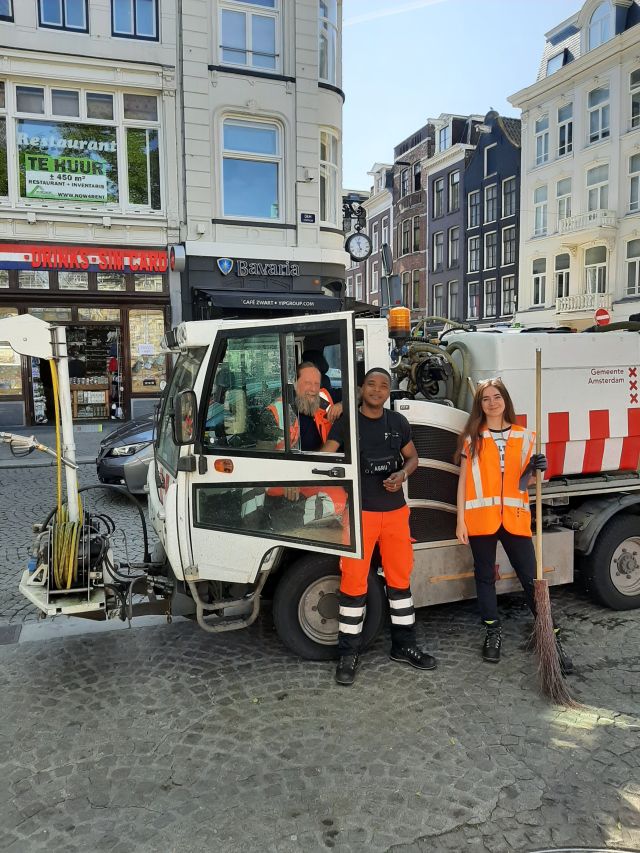Robots to keep public spaces clean. Is this the future for smart cities?
Amidst Amsterdam’s vibrant canals and historic streets, the need for efficient waste management is a pressing concern. Imagine a combination of human know-how and robot magic, working together to keep our city clean. Two MSc students explored how robotics can successfully reshape our urban landscape.

Amsterdam, known for its progressive spirit and innovation, is setting its sights on a cleaner and more sustainable future. In the city, the ‘Schoon’ (i.e. clean) department from the municipality works on keeping the streets spick and span.
For their thesis research, Enzo Steehouwer (MSc MADE) and Claire Schuurman (TU Delft) delve into the city's beating heart, accompanying and interviewing the very individuals responsible for maintaining Amsterdam. They wonder: how can these employees successfully team up with smart cleaning robots?
Design qualities for a future cleaning robot
First and foremost, Enzo found the successful introduction of a cleaning robot in the City of Amsterdam depends on whether or not the design incorporates themes important for the job satisfaction of employees.
Keeping this in mind, this thesis outlines a number of recommendations. Among others, the robot's introduction should not dilute the freedom cherished by the Schoon team. Instead, it must amplify their capabilities while preserving the cherished interactions with bystanders. Variety in their work should remain, ensuring monotony stays at bay. To form a successful team member of the Schoon department, the robot needs to be user-friendly for everyone in the department, communicate clearly, react to requests from City employees, and assist with tasks.
The cleaning robot's potential shines brightest during specific shifts, like when streets need a sweep or trash bins need emptying. By assisting in these tasks, the employees can focus on other things—increasing productivity of these shifts.”
— Enzo Steehouwer, MSc MADE alumni
Two design concepts: Mobile Robot Bin and Robot Container
During this research, Claire too finds that safeguarding employee values is crucial for a successful integration of robotic helping hands to maintain the city. This research takes us through a multidimensional exploration. Through insightful interviews, six core values have surfaced—values that form the cornerstone of job satisfaction.
Next, to determine how and where cleaning robots could add value in the city, the main waste problems in Amsterdam were identified and analyzed: inefficient waste management and littering behavior were often the cause. Based on this, a design vision for the robots took shape. Claire envisions: the robot should influence proper waste management behavior, promote ownership, and amplify waste management efficiency. To bring these ideas to life, two concepts emerged—the Mobile Robot Bin and the Mobile Robot Container.
The Robot Bin aims to motivate proper behavior through rewarding interactions and to increase waste collection efficiency. To align with Amsterdam's identity and raise awareness, the appearance will be created in collaboration with local artists.A fusion of technology and artistry, these concepts weave seamlessly into Amsterdam's identity, stirring curiosity and consciousness.
Meanwhile, the Robot Container focuses on providing waste disposal options at will in the city center, optimizing waste management efficiency and reducing littering behavior, as the current policy allows residents to place waste outside twice a week. The concept reduces the physical burden on employees by eliminating the need to collect waste from the street and minimizes the need for heavy waste trucks in the center.
As we unveiled the findings to the stakeholders from the City of Amsterdam, department ‘Schoon’ (clean) and AMS Institute, positive feedback flowed in. The Robot Container was the most promising solution for a cleaner future. Still, challenges such as vandalism need to be addressed before this innovation could become a reality.”
— Claire Schuurman, MSc MADE alumna

Personally, I found the most valuable insight in both projects to be that a good robot for a cleaner city is precisely not a 'cleaning robot'. In fact, there are a lot of things around cleaning that could use support–among employees, residents and visitors of the city.”
— Jered Vroon, Researcher at the Faculty of Industrial Design Engineering, TU Delft
More research and development needed
The outcome of these explorations is a glimpse into the future—an interplay of human and machine that could redefine Amsterdam's cleanliness. As long as the robot doesn't replace the human touch; but enhances it. Still the path to a cleaner Amsterdam with the help of robots asks for further research, development, and implementation. To be continued…